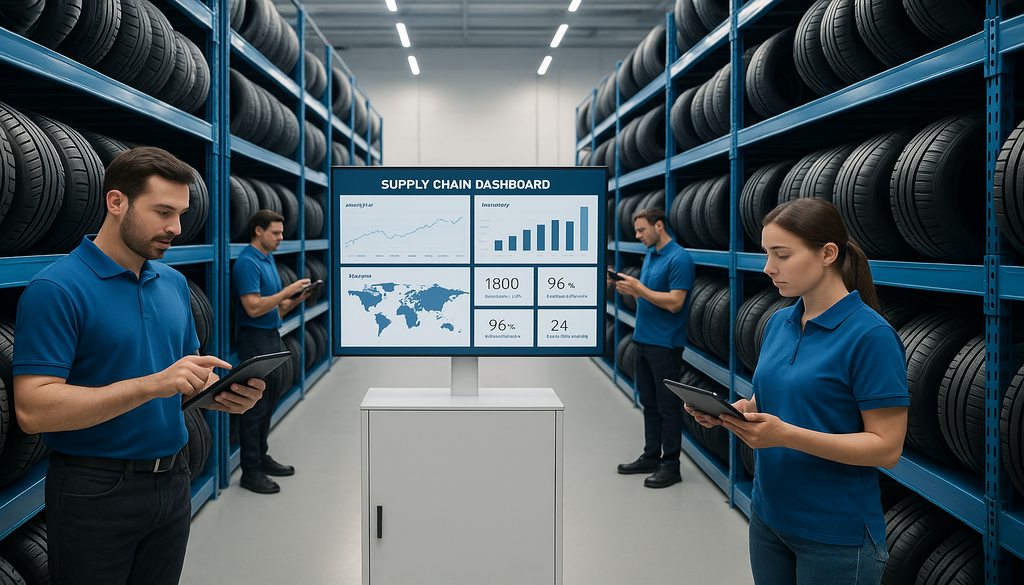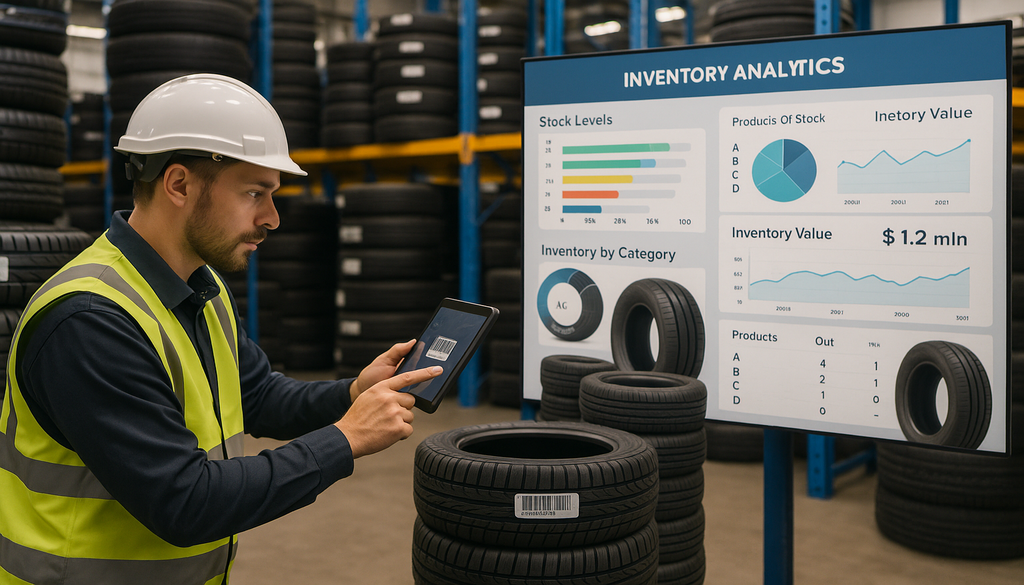In today's fast-paced world, tire distributors face increasing pressure to streamline operations, reduce costs, and meet growing customer expectations. Digital transformation has emerged as a critical solution to these challenges, offering tools that can dramatically enhance efficiency across the tire distribution chain. The shift toward digital solutions is no longer optional but necessary for businesses aiming to maintain competitive advantage in this evolving landscape. From inventory management to delivery logistics, technology is reshaping how tire products move from manufacturers to retailers and end consumers. This article explores seven digital tools that are making a significant impact on tire distribution efficiency and how forward-thinking companies are leveraging these technologies to drive business growth.
Overview of Digital Transformation in the Tire Industry
The tire distribution industry has undergone significant transformation over the past decade, evolving from predominantly manual processes to increasingly automated and digitized operations. Traditionally, tire distributors relied heavily on paper-based systems, phone orders, and basic computer programs that often operated in isolation from one another. This fragmented approach created inefficiencies, increased the likelihood of errors, and limited visibility across the supply chain. The introduction of digital technologies has revolutionized these outdated practices, offering integrated solutions that provide real-time data, automated workflows, and enhanced communication between all stakeholders. This evolution represents not just a technological upgrade but a fundamental shift in how tire distribution businesses operate and deliver value to their customers.
Adopting digital tools in the tire industry has become increasingly important due to several market pressures. Rising customer expectations for faster delivery times, accurate inventory information, and seamless ordering processes have pushed distributors to seek more efficient operational methods. Additionally, competitive pressures within the industry have intensified, with distributors constantly looking for ways to reduce costs while improving service quality. Digital tools address these challenges by streamlining processes, reducing manual work, and providing valuable data insights that enable better decision-making. Furthermore, the complexity of modern tire supply chains—often spanning multiple regions and involving numerous stakeholders—requires sophisticated coordination that only digital solutions can effectively provide.
The impact of digital transformation extends beyond operational improvements to create strategic advantages for tire distributors. Companies that embrace digital tools gain enhanced visibility into their operations, allowing them to identify bottlenecks, optimize resource allocation, and respond more quickly to market changes. These tools also enable distributors to offer value-added services that differentiate them from competitors, such as real-time tracking, proactive inventory alerts, and personalized customer experiences. Moreover, the data collected through digital systems provides valuable insights into customer preferences, market trends, and operational performance, informing strategic decisions that drive business growth. As the tire industry continues to evolve, digital transformation will remain a key driver of innovation and competitive advantage.
Enhancing Inventory Management with Advanced Software
Digital inventory management systems have become the cornerstone of efficient tire distribution operations. These sophisticated platforms provide comprehensive solutions that address the unique challenges of tire inventory, including the management of multiple sizes, brands, models, seasonal variations, and aging considerations. Modern inventory software offers real-time visibility into stock levels across multiple locations, enabling distributors to maintain optimal inventory levels while reducing carrying costs. These systems automate many previously manual processes, such as stock counts, reorder point calculations, and purchase order generation, significantly reducing the administrative burden on staff. Additionally, advanced inventory management solutions incorporate predictive analytics capabilities that analyze historical sales data, seasonal trends, and market conditions to forecast future demand with remarkable accuracy, allowing distributors to make proactive inventory decisions rather than reactive ones.
The benefits of implementing digital inventory management extend far beyond basic stock tracking. Real-time inventory updates ensure that all stakeholders—from warehouse staff to sales representatives—have access to accurate information about product availability. This transparency eliminates the frustration and inefficiency of discovering stock discrepancies during the fulfillment process and enables sales teams to make reliable commitments to customers. Error reduction represents another significant advantage, as digital systems minimize the human mistakes that commonly occur with manual inventory processes. Barcode scanning and RFID technology ensure accurate product identification and location tracking, while automated data entry eliminates transcription errors that can lead to costly inventory discrepancies. These improvements translate directly to enhanced customer satisfaction through improved fill rates and reduced instances of backorders or substitutions.
Advanced inventory management software also facilitates more sophisticated inventory strategies that can provide competitive advantages. Tire distributors can implement effective stock rotation programs that prevent aging inventory issues, particularly important in an industry where rubber products have limited shelf lives. Cross-location visibility enables more efficient distribution of inventory across a network, allowing distributors to fulfill orders from the optimal location based on proximity, stock levels, and transportation costs. Integration with warehouse management systems further enhances efficiency by optimizing storage locations, pick paths, and loading sequences. Some systems even incorporate supplier integration capabilities that automate communication with tire manufacturers, streamlining the replenishment process through electronic data interchange (EDI) or API connections. Collectively, these capabilities transform inventory management from a cost center to a strategic asset that contributes significantly to overall business performance.
The Role of Delivery Software in Streamlining Operations
Delivery software has revolutionized the final and often most challenging phase of the tire distribution process. Modern delivery management platforms incorporate sophisticated routing algorithms that consider multiple variables—including distance, traffic patterns, delivery time windows, vehicle capacities, and driver schedules—to create optimized delivery routes. These intelligent systems can reduce miles driven by 10-30%, resulting in significant fuel savings, reduced vehicle wear, and increased driver productivity. Dynamic routing capabilities allow for real-time adjustments based on changing conditions such as traffic delays or last-minute order additions, ensuring that delivery schedules remain efficient despite unforeseen challenges. The operational improvements facilitated by delivery software translate directly to bottom-line benefits, with many tire distributors reporting cost savings of 15-20% after implementing these solutions.
The impact of delivery software extends beyond operational efficiency to dramatically improve customer satisfaction. Real-time tracking capabilities provide customers with accurate updates on delivery status, eliminating uncertainty and reducing the need for status inquiries. Automated notification systems keep customers informed through their preferred communication channels, sending alerts at key points in the delivery process such as dispatch confirmation, approaching delivery, and successful completion. These features address the growing customer expectation for transparency throughout the fulfillment process. Additionally, electronic proof of delivery systems capture signatures, photos, and delivery notes digitally, creating an indisputable record of successful deliveries while eliminating paper-based documentation. The resulting improvement in service quality strengthens customer relationships and can significantly enhance retention rates in the competitive tire distribution market.
Integration between delivery software and other business systems creates a seamless operational flow that eliminates information silos. When connected with order management systems, delivery software can automatically receive new orders and initiate the delivery planning process without manual intervention. Integration with inventory management ensures that delivery schedules align with product availability, preventing promises of delivery for out-of-stock items. Some advanced systems even incorporate customer relationship management (CRM) integration, providing drivers with customer history and preferences to enable more personalized service during deliveries. Mobile applications for drivers serve as the front-end interface for these integrated systems, providing route guidance, customer information, digital documentation, and communication tools in a single platform. This comprehensive approach to delivery management transforms what was traditionally one of the most challenging aspects of tire distribution into a streamlined, data-driven process that enhances both operational efficiency and customer experience.
Building a Digital Backbone for Tire Distribution Networks
A digital backbone represents the integrated technological infrastructure that connects and coordinates all aspects of a tire distribution operation. This foundational framework consists of interoperable systems, shared data repositories, and standardized communication protocols that enable seamless information flow across the entire distribution chain. Unlike siloed solutions that address only specific functions, a comprehensive digital backbone creates a unified operational environment where data moves freely between applications, departments, and external partners. This interconnected approach eliminates the inefficiencies and errors that commonly occur when information must be manually transferred between systems. For tire distributors, a robust digital backbone typically encompasses enterprise resource planning (ERP) systems, warehouse management systems (WMS), transportation management systems (TMS), customer relationship management (CRM) platforms, and supplier portals, all working in concert to orchestrate the complex movements of inventory, information, and finances throughout the distribution network.
The integration of various digital tools across the distribution chain yields benefits that far exceed what individual systems can deliver in isolation. When inventory management software communicates directly with warehouse management systems, storage locations are automatically optimized based on product characteristics and demand patterns, while picking routes are designed for maximum efficiency. Seamless connections between order management and delivery systems ensure that customer promises are aligned with actual fulfillment capabilities, preventing disappointed expectations due to disconnected processes. Financial systems integrated into the digital backbone provide real-time visibility into the cost implications of operational decisions, enabling more informed choices about inventory investments, delivery schedules, and resource allocation. Perhaps most importantly, an integrated digital backbone creates a single source of truth for operational data, eliminating the confusion and inefficiency that result from conflicting information across different systems.
Building an effective digital backbone requires strategic planning and a phased implementation approach. Tire distributors should begin by conducting a thorough assessment of their current technological landscape, identifying existing systems, data structures, and process flows. This analysis reveals integration opportunities, redundancies, and gaps that must be addressed to create a cohesive digital environment. The selection of integration technologies—such as API gateways, enterprise service buses, or data lakes—should align with the organization's specific needs, technical capabilities, and growth projections. Many distributors find that modern cloud-based platforms offer advantages in terms of scalability, flexibility, and ease of integration compared to legacy on-premises solutions. Implementation typically proceeds incrementally, prioritizing high-value integration points that deliver immediate operational benefits while building toward the long-term vision of comprehensive connectivity. Throughout this journey, successful distributors maintain a dual focus on technological capabilities and the business processes they enable, recognizing that digital transformation is ultimately about enhancing human workflows rather than simply deploying new software.
Case Studies: Success Stories in Modern Tire Distribution
Regional Tire Distributors, a mid-sized company serving the Midwest, demonstrates the transformative impact of comprehensive digital adoption on operational efficiency. After implementing an integrated suite of digital tools including inventory management, warehouse automation, and delivery optimization software, the company achieved remarkable improvements across multiple performance indicators. Order processing time decreased by 65%, from an average of 45 minutes to just 16 minutes per order, enabling the company to handle a 30% increase in order volume without adding staff. Delivery route efficiency improved by 22%, reducing fuel costs and enabling more deliveries per vehicle per day. Perhaps most impressively, inventory accuracy increased from 89% to 99.5%, virtually eliminating the costly stockouts and emergency shipments that had previously eroded profitability. The company's leadership attributes these gains to the seamless integration between systems, which eliminated redundant data entry and provided decision-makers with real-time visibility across all operations, allowing them to identify and address issues proactively rather than reactively.
Continental Tire Distribution, a national distributor with operations across multiple states, offers compelling evidence of how digital tools can enhance customer relationships while streamlining internal processes. The company implemented a customer portal integrated with their inventory and delivery systems, giving their retailer customers unprecedented visibility into product availability, pricing, and order status. This self-service platform now handles 78% of all orders, reducing the administrative burden on the sales team while providing customers with 24/7 ordering capabilities. The portal's integration with Continental's inventory management system ensures that customers see accurate, real-time availability information, reducing order amendments by 62%. Additionally, the delivery tracking feature has decreased customer service calls by 45%, as retailers can independently monitor their deliveries without contacting Continental's customer service team. The company reports that customer satisfaction scores have increased by 28 percentage points since implementing the integrated digital platform, demonstrating that operational improvements and enhanced customer experience go hand in hand.
Pacific Rim Tire Supply illustrates how even smaller distributors can leverage digital tools to compete effectively against larger competitors. This West Coast distributor serving independent tire retailers implemented a cloud-based distribution management system specifically designed for tire wholesalers. The platform's comprehensive approach integrated inventory, purchasing, sales, and delivery functions in a single system with modest implementation costs appropriate for a business of their size. The results were transformative: stockouts decreased by 73% while inventory investment decreased by 18%, indicating much more efficient inventory management. Order accuracy improved to 99.8%, virtually eliminating costly returns and credit processing. Most significantly, the company reported that their perfect order rate—orders delivered complete, accurate, and on time—increased from 76% to 94%, giving them a significant competitive advantage in their market. Pacific Rim's experience demonstrates that digital transformation is not limited to large enterprises with substantial IT budgets; appropriately scaled solutions can deliver proportional benefits to distributors of all sizes who approach implementation strategically.
Future Trends in Tire Industry Technology
Artificial intelligence and machine learning represent the next frontier for tire distribution technology, promising to enhance decision-making across all operational areas. Predictive demand forecasting algorithms will analyze complex patterns in historical sales data, market conditions, weather patterns, and even social media trends to anticipate future demand with unprecedented accuracy. AI-powered inventory optimization will automatically adjust stock levels and distribution across warehouse networks based on predicted demand patterns, reducing both stockouts and excess inventory. In delivery operations, machine learning algorithms will continuously analyze delivery performance, traffic patterns, and customer preferences to refine routing strategies beyond what current systems can achieve. Natural language processing will transform customer service through intelligent chatbots capable of handling routine inquiries and troubleshooting complex issues. As these technologies mature, they will transition from providing recommendations that inform human decisions to increasingly autonomous systems that execute routine decisions independently, allowing distribution professionals to focus on exceptions and strategic initiatives.
The Internet of Things (IoT) will create unprecedented visibility and control throughout the tire distribution chain. Smart warehouses equipped with connected sensors will monitor environmental conditions such as temperature and humidity that can affect tire quality, automatically alerting managers to conditions that fall outside acceptable parameters. RFID and advanced tracking technologies will enable real-time location monitoring of individual tires throughout the warehouse and delivery process, virtually eliminating lost inventory and misplaced products. Connected delivery vehicles will transmit real-time data on location, speed, temperature, and even driver behavior, enabling proactive management of the delivery fleet and early intervention when issues arise. Perhaps most transformatively, smart tires with embedded sensors will communicate directly with distribution systems, providing data on tread wear, pressure, and performance that informs inventory decisions and enables predictive maintenance services. This connected ecosystem will generate enormous volumes of operational data that becomes a strategic asset when properly analyzed and applied to business decisions.
Blockchain technology holds particular promise for addressing transparency and authenticity challenges in tire distribution. Immutable digital records created through blockchain will document the complete chain of custody for premium tires, combating counterfeiting and providing consumers with confidence in product authenticity. Smart contracts will automate transactions between manufacturers, distributors, and retailers, ensuring that payments, deliveries, and information exchanges occur according to predefined rules without manual intervention. For warranty and recall management, blockchain provides an unalterable record of which specific tires were sold to which customers, enabling precise targeting of recall notices and warranty service. As sustainability concerns increase throughout the industry, blockchain will also facilitate tracking of recycled materials and responsible disposal practices, allowing environmentally conscious distributors to verify and promote their green credentials. These applications demonstrate how blockchain extends beyond its cryptocurrency origins to address fundamental business challenges in tire distribution and other industries with complex supply chains.
Conclusion
The digital transformation of tire distribution represents more than just technological advancement—it fundamentally redefines how businesses operate in this sector. The seven digital tools explored in this article collectively create a more efficient, responsive, and customer-centric distribution model that can adapt to changing market conditions. Companies that embrace these technologies gain not only operational efficiencies but also strategic advantages through enhanced decision-making capabilities and improved customer experiences. As we've seen through various case studies, the benefits of digital adoption are tangible and significant, ranging from cost reduction to service improvement. Looking ahead, emerging technologies like AI, IoT, and blockchain promise to further revolutionize tire distribution, creating new opportunities for innovation and differentiation. For tire distributors, the path forward is clear: embracing digital transformation is no longer optional but essential for long-term success in an increasingly competitive and dynamic marketplace.
Frequently Asked Questions (FAQ)
Q1: How do digital inventory management systems benefit tire distributors?
Digital inventory management systems offer tire distributors critical advantages by providing real-time visibility into stock levels, reducing manual errors, and enabling more accurate forecasting. These systems facilitate efficient stock rotation, prevent overstocking or stockouts, and enhance order fulfillment processes, ultimately leading to improved operational efficiency and customer satisfaction. Additionally, they help distributors manage the complexity of tire inventory, including multiple SKUs, seasonal variations, and special orders, while providing data-driven insights that optimize inventory investment and improve cash flow. Many distributors report inventory cost reductions of 15-20% while simultaneously improving product availability after implementing these systems.
Q2: What are the key features to look for in delivery software for tire distribution?
Key features in delivery software for tire distribution include route optimization, real-time tracking, automated scheduling, and customer communication tools. These features help in reducing delivery times, lowering operational costs, and improving service quality. Additionally, integration capabilities with other systems like inventory and customer relationship management are crucial for seamless operations. Look for solutions that offer mobile applications for drivers, electronic proof of delivery, capacity planning, and analytics dashboards that provide insights into delivery performance. The most effective delivery software will also accommodate the unique aspects of tire delivery, such as variable product sizes, weight considerations, and specialized handling requirements for different tire types.







